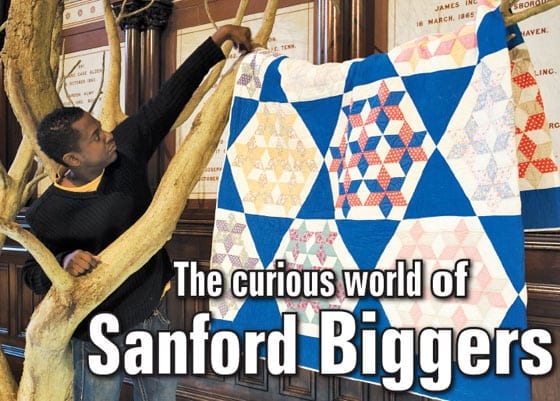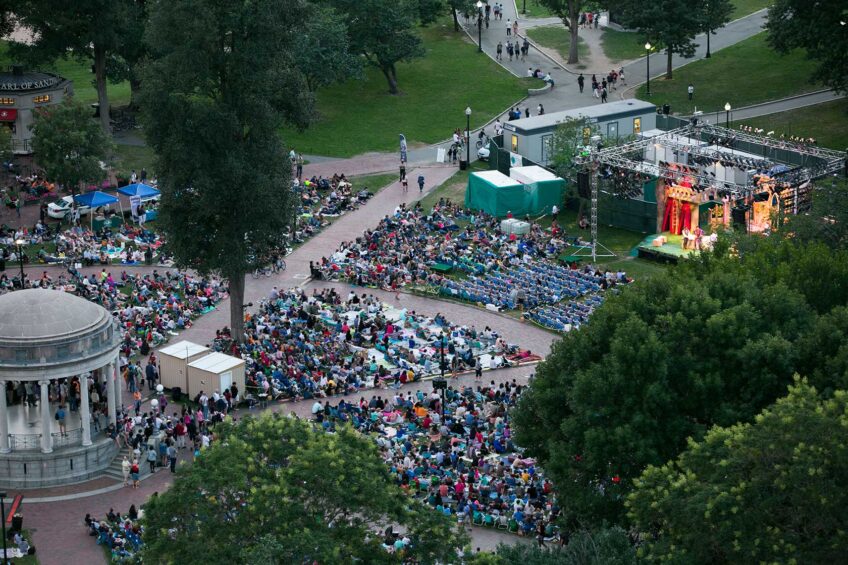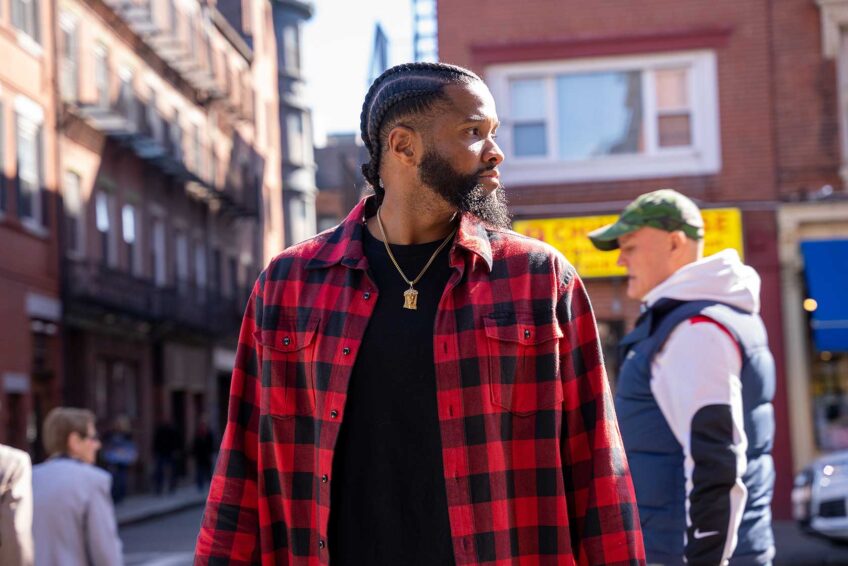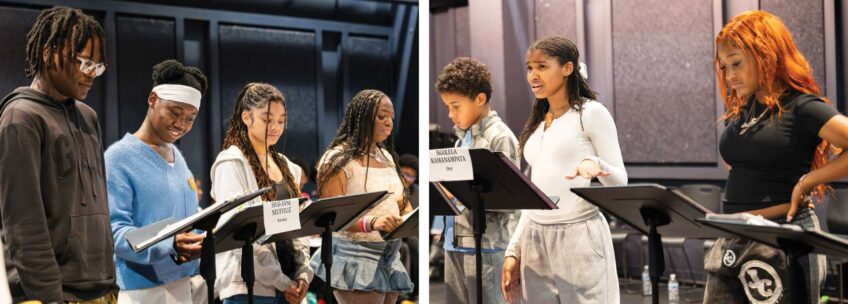
A leafless tree stands in the Memorial Transept of Harvard’s Memorial Hall, erected a decade after the Civil War to honor Harvard men who died fighting for the Union cause.
In contrast to the gothic structure’s gleaming marble corridor, ornate black walnut carvings and soaring, ruby-hued stained glass windows, the tree is a stark gray presence. Yet it exerts quiet power.
Its bare branches frame the white marble plaques that bear the names of the fallen men and where they died—places like Gettysburg, Lookout Mountain, and Bull Run.
The tree, and the temporary installation of which it is part, “Constellation (Stranger Fruit),” interrupts passersby. Usually, few pause to reflect on the historic significance of the transept, which functions as the lobby into Sanders Theater. The structure draws viewers into attentive contemplation of the tablets and the native silence of the memorial.
“The bare tree suits the quiet here, and the time of year we’re beginning now,” says Sanford Biggers, the artist who created the temporary installation, on view until Dec. 2. Wearing a navy blue sweater and jeans, Biggers exudes calm energy, perhaps reflecting his years of meditation, a practice he learned in Japan.
Biggers is the 2009 Marshall S. Cogan Artist in Residence through the Public Art Program at the Office for the Arts at Harvard, which commissioned his installation.
The fabricated tree, composed of steel, wire mesh and epoxy, introduces a natural form into the complex geometry of the hall, evoking the cycle of life associated with the change of seasons.
“It’s my third tree,” says Biggers, whose installations mine diverse cultural associations. In the East, a tree may suggest the life-giving Bodhi tree under which the Buddha finds enlightenment. Here, a tree can be laden with America’s history of lynching.
In an earlier installation, “Blossom” (2007), a player piano impaled by a tree trunk performs a dirge-like rendering of the American jazz standard “Strange Fruit.” Made famous by Billie Holiday, the Abel Meeropol ballad was inspired by the 1930 lynching of two black men.
Biggers’ installation in the Memorial Transept evokes the history of Boston as a destination on the Underground Railroad. His installation suggests that its conductors were multi-media artists in their own right, using coded messages stitched in quilts, verses in African-American spirituals and stellar navigation to help slaves plan their escape. “Harriet Tubman was an astronaut,” said Biggers with a smile.
Biggers has draped a traditional American quilt among the branches of the tree. Based on the constellation Taurus, its Seven Stars pattern of diamond-shaped designs echoes the geometric inlays on the walls and floors of the transept.
The tree stands on a platform of interlocking panels, each sparkling with starry lights that suggest the routes followed by escaping slaves as they journeyed north to freedom.
Raised in Los Angeles, Biggers, 39, draws his cultural references from the Pacific Rim as much as from urban America. He spent three years in Japan, where he learned the language and studied Soto Zen.
As a visual artist and musician, Biggers explores convergences among cultures, events, religions and eras. His wry, evocative installations often combine sculpture, video, music and live performance. He has had solo exhibitions at museums and galleries throughout the U.S. and overseas, including the Tate Modern in London, the Whitney Museum and Studio Museum in Harlem in New York, and the Art Institute of Chicago, where he received an MFA. In January, Biggers will begin an appointment as assistant professor at the Columbia University School of the Arts.
Collaborating with follow artists who share his appetite for cross-pollination, Biggers continuously expands the reach and richness of these convergences. Mandalas, Buddhist sand paintings, and giant Afro picks find their way into his works as do Sufi chants, break-dancing competitions, ritual jazz improvisations, and hip-hop samples.
The Harvard installation and a related live performance extend his exploration of the African Diaspora to the cosmos.
Evoking the Japanese tradition of Sakura — communal festivals of song and dance under cherry trees in full bloom — Biggers will stage a 30-minute performance on Nov. 18 with the installation as its centerpiece. Joining him will be jazz vocalists Imani Uzuri and Sumie Kaneko as well as Harvard’s black a capella ensemble KeyChange, a group dedicated to music of the African Diaspora, including RandB, hip-hop, neo-soul, and Motown.
Kaneko is a 2006 graduate of the Berklee College of Music and an award-winning performer of traditional Japanese instruments. She will play the koto, a zither-like wooden string instrument, as Uzuri sings passages from the free-jazz big band pioneer Sun Ra and verses from the Sufi poet Rumi.
Summoning a tradition of African-American spirituals, Uzuri and the KeyChange singers will also engage in a call-and-response improvisation as they perform their remix of “Strange Fruit,” entitled “Stranger Fruit.”
“Imani Uzuri is an ordained minister,” says Biggers. “She has the role of an oracle. As she sings by the tree on the platform, she’ll stand among the stars.”
“Constellation (Stranger Fruit)” is on view until Dec. 2 in the Memorial Transept of Memorial Hall, 45 Quincy St., Cambridge, one block from the T stop at Harvard Square.
Memorial Hall is open weekdays from 10 a.m. – 6 p.m., Saturdays from noon – 6 p.m., and Sundays from noon – 3 p.m.
Admission is free to Memorial Hall and to these related events:
• A Conversation with Sanford Biggers on Nov.16 at 6 p.m. at the Harvard Art Museum, 485 Broadway, Cambridge.
• A 30-minute performance on Nov. 18 at 4 p.m. in the Memorial Transept.






